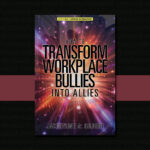“It is disgraceful when one human being, with no identifiable difference from another person other than a job title or position on an organization chart, can act with total disregard for that other person (Namie & Namie, 2011, p. 101).
In the years I’ve taught human resource management, I don’t recall seeing a mention of bullying at work within textbooks – or more specifically, a legislative means to curb its occurrence. This is curious, considering that self-management precedes the effective governance of other people.
Bullies are a virulent breed. Namie and Namie (2011) chronicle the devastating impact of individuals who lack self-control on the workforce:
“Remarkably, for 30 percent of women targets and 21 percent of men targets, the injury they sustain from bullying is PTSD! Imagine a war wound created at work by another person who intentionally meant to harm the target. (p. 94). Working in a constant state of anxiety as a result of threats, humiliation, and intimidation generates a health-harming work environment for the employee.” (p. 91).
The current lack of attention (to legal remedies) may not be surprising when you consider the bombshell buried inside Gary and Ruth Namie’s latest book: The Bully-Free Workplace: Stops Jerks Weasels and Snakes from Killing Your Organization. They state that The Society for Human Resource Management opposes anti bullying legislation (e.g., The Healthy Workplace Bill (HWB)) in several states: “It is the official position of the HR industry to oppose societal means of addressing workplace bullying” (Namie & Namie, 2011, p. 129).
It’s important that we as management educators not only define bullying, but that we go the extra mile in describing (1) its harmful impacts; (2) posturing vs. participatory management; and (3) the remedies that organizations can take to curb “weasels” from multiplying. Merely explaining traditional human resource management concepts (like staffing, performance appraisal, recruitment, and selection) is ineffectual if the person learning those terms believes bulldozing the workers he/she recruits, selects, and appraises is acceptable. How in the world can you direct other people if you’re unable to control yourself?
Bullying is inversely proportional to the target’s appetite for confrontation. A smattering of the hallmarks of human decency can go a long way in the formation of student perceptions. Aggressive interaction is in fact ignorance, and smacks of an improper educational footing. It is manifested first in a trampling of one’s co-workers, followed by a second round of abuse: a non-acknowledgment of the blow.
If perpetrators don’t apologize one can only assume that they don’t know what constitutes bad form, and/or they don’t consider the target worthy of respect. A half-baked character is the result of a lifetime of non-confrontation by those who sabotage their peers (1) through snitching; and by (2) discussing them behind their backs.
The lack of emphasis on positive human relations may be part of a larger problem. In a 2003 survey of 239 business school deans, only 31 percent strongly agreed with the statement: “The faculty at my business school is interested in discussing the social impacts of business decision making.” (Woo, 2003). Willimon and Naylor share the one-track mindset of business students at Duke:
“For several years students in our School of Business were asked to write a personal strategic plan for the ten year period after their graduation. The question posed to them was ‘What do you want to be when you grow up?’ With few exceptions, they wanted three things: money, power, and things (very big things, including vacation homes, expensive foreign automobiles, yachts, and even airplanes). Primarily concerned with their careers and growth of their financial portfolios, the personal plans contained little room for family, intellectual development, spiritual growth, or social responsibility. Their mandate to the faculty was, ‘Teach me how to be a moneymaking machine.’ All else was irrelevant” (Willimon & Naylor, 1995).
There is a correlation between self-concern and authoritarian management, the product of which results in organizational behavior that is with few exceptions markedly undemocratic (Adizes, 1979).
______________________________________________________________________________
References
Adizes, I. (1979). How to solve the mismanagement crisis: Diagnosis and treatment of management problems. New York, NY: Irvington Publishers.
Namie, G., & Namie, R. F. (2011). The bully-free workplace: Stop jerks, weasels, and snakes from killing your organization. New Jersey: John Wiley & Sons.
Willimon, W. H., & Naylor, T. H. (1995). The abandoned generation: Rethinking higher education (p. 38). Grand Rapids, MI: Williams H. Eerdmans Publishing Company.
Woo, C. W. (2003, May/June). Personally responsible: The basis of an ethics education revolves around teaching business students a sense of individual responsibility. BizEd, p. 27.





Recent Comments